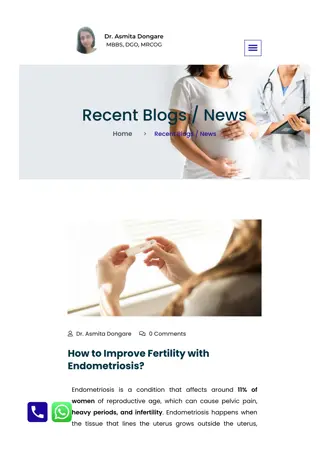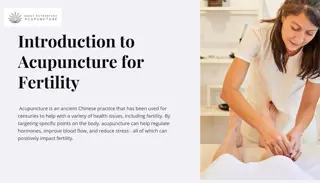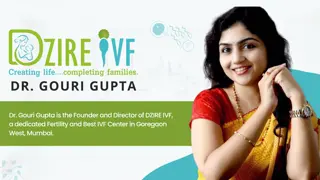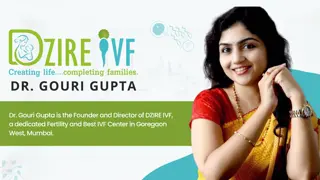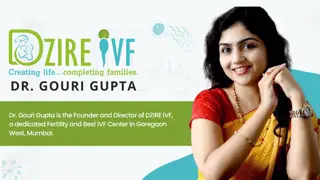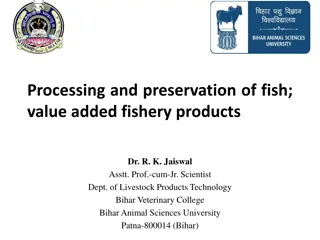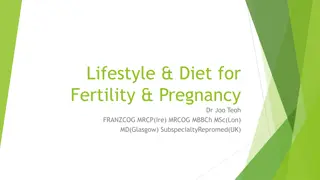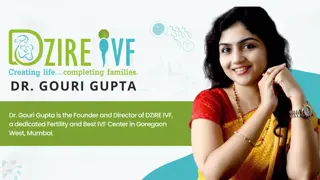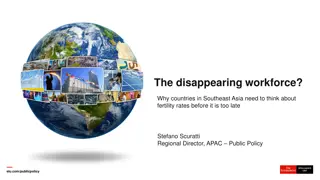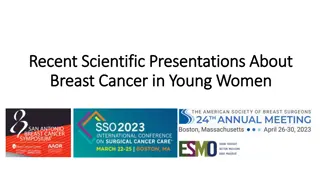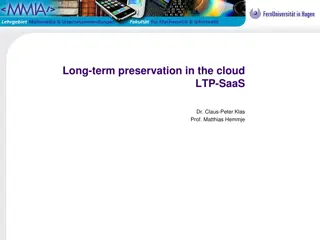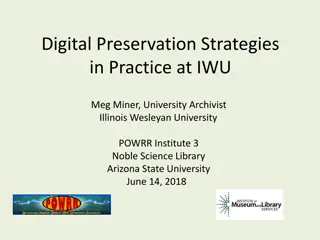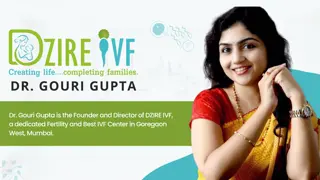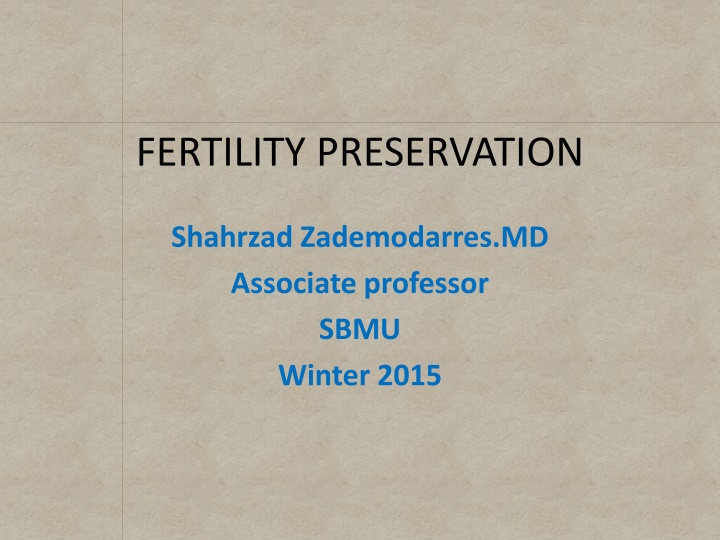
Fertility Preservation in Cancer Patients and Beyond
Learn about the importance of fertility preservation in cancer patients and individuals with non-oncological conditions, such as autoimmune disorders. Discover the risk factors for ovarian failure, the effects of chemotherapy and radiotherapy on fertility, and how to discuss fertility preservation options with patients anticipating treatment. Consider referring patients to reproductive specialists for further guidance.
Download Presentation

Please find below an Image/Link to download the presentation.
The content on the website is provided AS IS for your information and personal use only. It may not be sold, licensed, or shared on other websites without obtaining consent from the author. If you encounter any issues during the download, it is possible that the publisher has removed the file from their server.
You are allowed to download the files provided on this website for personal or commercial use, subject to the condition that they are used lawfully. All files are the property of their respective owners.
The content on the website is provided AS IS for your information and personal use only. It may not be sold, licensed, or shared on other websites without obtaining consent from the author.
E N D
Presentation Transcript
FERTILITY PRESERVATION Shahrzad Zademodarres.MD Associate professor SBMU Winter 2015
introduction The increasing survival rates of cancer patients have encouraged many specialists to focus on the irreversible consequences of chemotherapy and radiotherapy. Similarly to cancer patients, there are some nononcological conditions currently treated with gonadotoxic agents, such as patients with autoimmune disorders or some chromosomal abnormalities that can lead to ovarian failure.
introduction There are also other situations where a woman may benefit from fertility preserva- tion procedures, such as a woman with severe or recurrent endometriosis or a woman who wants to postpone conception until her late reproductive years .
INTRODUCTION Risk factors for ovarian failure Age Ovarian reserve (FSH-AMH-AFC) Dose related
Effect of chemotherapy the drug dose dose-intensity method of administration (oral VS intravenous) disease age sex pretreatment fertility
effect of radiotherapy Direct damage to ovaries Damage to hypothalamic-pituitary axis
effect of radiotherapy Dose dependent: Total dose and fractionation schedule Age dependent: size of primordial follicle pool Radiation field Could also affect uterine function (M/C, IUGR, Premature deliveries)
Discuss the risk of infertility and fertility preservation options with patients with cancer anticipating treatment Medical oncologists, radiation oncologists, gynecologic oncologists, urologists, hematologists, pediatric oncologists, and surgeons, as well as nurses, social workers, psychologists, and other nonphysician providers
Discuss fertility preservation with all patients of reproductive age (and with parents or guardians of children and adolescents) Refer patients who express an interest in fertility preservation (and patients who are ambivalent) to reproductive specialists
Address fertility preservation as early as possible, before treatment starts Document fertility preservation discussions in the medical record
Embryo cryopreservation Embryo cryopreservation is an established fertility preservation method, and it has routinely been used for storing surplus embryos after in vitro fertilization More flexible ovarian stimulation protocols for oocyte collection are now available
Embryo cryopreservation Timing of this procedure no longer depends on the menstrual cycle in most cases stimulation can be initiated with less delay compared with old protocols.
Embryo cryopreservation If the cancer patient presented in the late follicular phase: Ovarian stimulation without GnRH antagonist was started if the follicle cohort following the lead follicle was <12 mm and stayed <12 mm before a spontaneous LH surge
After the LH surge, GnRH antagonist was started when the secondary follicle cohort reached 12 mm to prevent premature secondary LH surge If the follicle cohort following the lead follicle reached 12mmbefore the spontaneous LH surge, pituitary suppression with GnRH antagonist was initiated and continued until triggering final oocyte maturation with hCG or GnRH agonist
If the patient presented in the luteal phase: ovarian stimulation was started in the absence of GnRH antagonist . Similarly to conventional COS, GnRH antagonist administration was initiated later in the cycle, when the follicle cohort reached 12 mm, to prevent premature secondary LH surge and was continued until the hCG or GnRH agonist trigger
Cryopreservation of unfertilized oocytes patients who do not have a male partner do not wish to use donor sperm have religious or ethical objections to embryo freezing.
Cryopreservation of unfertilized oocytes Oocyte cryopreservation should be performed in centers with the necessary expertise. As of October 2012, the American Society for Reproductive Medicine no longer deems this procedure experimental
Cryopreservation of unfertilized oocytes Steps of Oocyte Cryopreservation Program Concealing: Ovarian Hyperstimulation Egg Retrieval Oocyte freezing( Slow freezing/vitrification) Oocyte Thawing IVF/ICSI Embryo Transfer
Ovarian transposition Ovarian transposition (oophoropexy) can be offered when pelvic irradiation is performed as cancer treatment. because of radiation scatter, ovaries are not always protected, and patients should be aware that this technique is not always successful
Ovarian suppression there is insufficient evidence regarding the effectiveness of GnRHa and other means of ovarian suppression in fertility preservation
Ovarian tissue cryopreservation and transplantation Ovarian tissue cryopreservation for the purpose of future transplantation does not require ovarian stimulation or sexual maturity and hence may be the only method available in children.
Ovarian tissue cryopreservation and transplantation It is considered experimental and should be performed only in centers with the necessary expertise A theoretic concern with reimplanting ovarian tissue is the potential for reintroducing cancer cells depending on the type and stage of cancer, although so far there have been no reports of cancer recurrence.
Ovarian tissue cryopreservation and transplantation 11 Live birth till now in the world Ovarian reserve tests are needed before banking: FSH AMH AFC Most useful for hematopoeitic cell transplant To be offered to patients with a good long term prognosis
Conservative gynecologic surgery interventions to spare fertility have generally centered on doing less radical surgery with the intent of sparing the reproductive organs as much as possible. Ovarian cystectomy can be performed for early-stage ovarian cancer
estrogen-sensitive breast and gynecologic malignancies Ovarian stimulation protocols using the aromatase inhibitor letrozole have been developed and may ameliorate Studies do not indicate increased cancer recurrence risk as a result of subsequent pregnancy
Fertility preservation in children Suggest established methods of fertility preservation ( semen or oocyte cryopreservation) for postpubertal minor children, with patient assent and parent or guardian consent. For prepubertal minor children, the only fertility preservation options are ovarian and testicular cryopreservation, which are investigational
preservation of fertility in males Sperm cryopreservation is effective Hormonal therapy in men is not successful in preserving fertility. It is not recommended. testicular tissue cryopreservation and reimplantation or grafting of human testicular tissue, should be performed only as part of clinical trials or approved experimental protocols
preservation of fertility in males It is strongly recommended that sperm be collected before initiation of treatment because the quality of the sample and sperm DNA integrity may be compromised after a single treatment session


